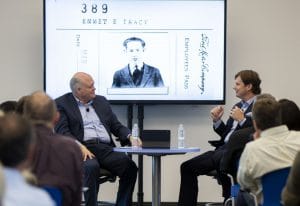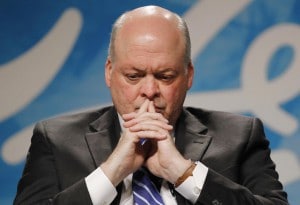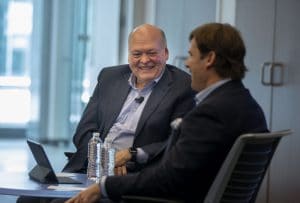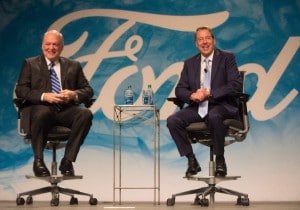Ford Motor Co. Chief Executive Jim Hackett will be stepping down on Oct. 1, with the automaker’s 58-year-old chief operating officer Jim Farley named to replace him.
Ford has gone through a series of management changes in recent years, the second-largest Detroit automaker struggling to reverse its declining market share, earnings and stock price. But Hackett’s retirement had been expected for some time and Farley was seen as his likely successor following a spring shake-up that saw his primary rival retire.
The 65-year-old Hackett was brought in as a change agent for a company that admittedly had lost its way – much as former Boeing exec Alan Mulally had been a decade earlier. A one-time CEO at office furniture company Steelcase, Hackett championed what he termed a more “human-centered” approach to reconnect with customers.
(Ford CEO Hackett retiring, Farley assuming role in October.)
He ordered some risky and controversial moves, including the elimination of virtual all of Ford’s passenger car models in favor of SUVs and CUVs, while also emphasizing electric, autonomous and connected vehicles.

Ford CEO Jim Hackett talks with his successors, COO Jim Farley. Hackett installed Farley to the chief operating officer’s job last year.
For his part, Farley said “nothing’s chang(ing)” from the Hackett playbook, though the one-time Toyota product planner made it clear that he sees tremendous opportunities to enter new high-tech arenas, including in-car entertainment, which could prove particularly useful in tomorrow’s autonomous vehicles.
“I think we’re in a great position,” Farley added during a media conference call following news of his elevation.
He will have plenty of challenges passed on from his processor. Ford has been struggling since the middle of the last decade – problems with its earnings, market share and stock price triggering the ouster of former CEO Mark Fields in May 2017, and a series of management changes since then. Ford’s stock price has fallen so low that its market cap is within striking distance of some new competitors such as Nikola Motors, the Phoenix-based startup that has yet to produce any of the hydrogen-powered electric trucks it is developing.
During the call, Farley listed new automotive players like Tesla, as well as high-tech giants Apple and Amazon, among the competitors Ford must address, as much as traditional automakers like General Motors and Toyota.
While Jim Hackett was a relative short-timer in the CEO spot, he helped set the company up for revival, said an effusive Bill Ford, the great-grandson of company founder Henry Ford, and the automaker’s chairman.

Ford CEO Jim Hackett faced several dilemmas during his tenure atop the Dearborn, Michigan-based automaker.
(Ford names Farley COO; President, Automotive Hinrichs retires.)
“Thanks to Jim (Hackett) we are a very different company than we were three years ago,” he said.
Considering the automaker’s propensity in recent years to reach outside its ranks when it needs to make significant changes, there had been some speculation Ford would do the same thing when it came for Hackett to step down – though Farley appeared to cement his position following the management shake-up earlier this year that saw Ford autos chief Joe Hinrichs step down.
The automaker’s board “talked about” reaching beyond its executive suite, said Bill Ford. “We did throw some names around. But every time we did that we felt Jim Farley’s name rose to the top.”
Despite the upbeat tenor of Tuesday’s conference call, there is no question Farley will face some significant challenges going forward. The automaker reported an adjusted pre-tax loss of $1.9 billion for the second quarter – though that was significantly better than Wall Street had expected, Hackett stressed, giving Farley, as COO, credit for reining in expenses as the pandemic hit the entire industry as hard as any crisis since the Great Recession more than a decade ago.
The new CEO could get a big boost in the months ahead as Ford rolls out a series of critical products, including the reborn Bronco, the new Bronco Sport, the automaker’s first long-range all-electric model, the Mustang Mach-E, and the redesigned F-150 pickup. It will need to ensure all four launches go smoothly, avoiding the botched launch of the Ford Explorer SUV in late 2019 that, according to many analysts, sank the prospects of Hinrichs, once seen as a strong candidate to replace Hackett.
Born in 1962 in Buenos Aires, where his father was serving as a bank executive, Farley has deep ties to Ford, his grandfather joining the company in 1962. But he joined Toyota in 1990, after a stint with IBM, serving initially as a product planner but rapidly rising through the ranks. He helped in the launch of the now successful but then-uncertain Lexus luxury brand, as well as Toyota’s ultimately failed attempt to create a youth-oriented marque, Scion.
He jumped to Ford in 2007 and, despite a tendency to be abrupt and demanding – his “F-“ or “Farley-bombs” are renowned within the company – he quickly won over skeptics with an encyclopedic knowledge of the company and a strong sense of changing consumer tastes. During the past 13 years, Farley has served in a variety of positions, including as head of the Lincoln brand as it began a product-driven revival. He also helped lead Ford’s high-tech program which is seen as one of the keys to the company’s future growth opportunities.
(New Ford CEO Hackett draws comparisons to former chief Mulally.)
With Ford now trying to pull things back in shape after the initial hit of the pandemic, said Hackett, this seemed like the right time to trigger “a smooth transition.”


